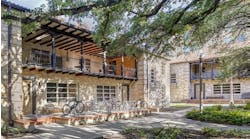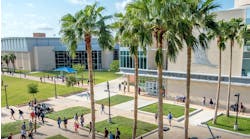Describe your school. Does the word "happy" come to mind? Many districts provide mission and vision statements; however, "happy" does not seem to appear.
Rick Miller, the founder of Kids at Hope, a program that empowers students for success, recently wrote a newspaper article, "Why Shouldn't our Schools, Teachers, Staff be Happiest on Earth?" Miller states that schools theoretically possess the three most basic elements to create a "happy school." They provide places where children get to be with their friends; learn new knowledge and skills to dream, grow, plan and prepare for the future; and are surrounded by adults who care about them.
The physical environment contributes to a happy school. Studies have proven that building conditions can affect the attitudes of students, teachers and parents. People feel better about themselves when their surroundings are pleasant.
Architects, facility planners and educators must consider the impact that design has on student and teacher attitudes. Staff members pleased with a building design create a happy learning experience for students. Those displeased with the design of the school, their space, physical conditions, even leadership, create unhappiness.
In one example, a vision committee selected a continuous-progress educational philosophy for its new school. The design created three neighborhoods, each using the open classroom concept grouped around a flexible team learning area and forum. Once the building opened, administrators and teachers were unhappy because they found it difficult to adjust to the openness. Eventually, the district appointed a new principal — someone who served on the vision committee and bought into the design concept.
In another case, a newspaper reported a "sick school" with a history of malfunctioning ventilation equipment, dripping mold and high carbon-dioxide levels that made inhabitants ill. The high school in question was built in 1977 and was heralded for its innovation in energy conservation. Typical for its time, it had few windows and tight ceiling space for mechanical equipment. But in subsequent years, headlines showed that the facility was not a happy environment.
The crumbling facility infrastructure problems reported in the 1996 GAO report "School Facilities: America's Schools Report Differing Conditions" still are with us. Many schools have not been repaired.
Staff and students are affected by more than just the building and learning environment. But a beautiful, functional, maintained and safe physical environment can enrich their working and learning experiences.
Miller concludes that creating learning institutions where people experience happiness and hopefulness should be a top priority.
James E. Rydeen, FAIA, is an architect/facility planning specialist and former president of Armstrong, Torseth, Skold & Rydeen, Inc. (ATS&R), Minneapolis. He can be reached at [email protected].

